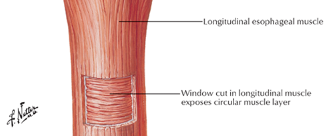ENGINEERING OF SOFT TISSUE-TISSUE INTERFACESTissue-tissue transitions are comprised of complex structures, which are inhomogeneous in terms of function, structure and composition. The esophageal tissue, for example, exhibits a structure properties of which are changing both axially and radially.
In the simplest description, the esophagus is a muscular canal (18-25 cm for adult human) consisting of cervical, thoracic, and abdominal parts. The cervical esophagus contains muscle fibers, which are organized differently along its thickness: the outer layer is formed by longitudinally arranged fibers, while the inner layer containing circularly oriented fibers (Fig-1).
Furthermore, its wall can be divided into four continuous layers (inner to outer): mucosa, submucosa, muscularis externa and adventitia, containing smooth muscle cells, fibroblasts and epithelial cells.
Cancer, esophageal atresia, and anastomosis are the major conditions requiring esophageal surgeries, and the results of current treatment options have been less than optimal, resulting in leakage, stricture, elongation, and malnutrition [1,2,3]. Therefore, there is an urgent need for alternative approaches, and interface tissue engineering could provide solutions to these problems.
A technology that allows for the fabrication of matrices with structures(e.g., variations in fiber orientation) mimicking the esophageal tissue could be very attractive for the regeneration of esophageal tissue. The respective zones of the matrices could be incorporated with appropriate stimulants for the development of stem cells into zone specific cell types.
[1] Zhu et al. (2006) Biomaterials 27: 68–78. [2] Zani et al. (2009) Seminars in Pediatric Surgery 18: 57-62. [3] Saxena et al. (2010) Journal of Pediatric Surgery 45: 859–864.
|

|
Fig-1. Orientation of muscle fibers in the cervical esophagus (Source: http://www.nature.com/gimo/contents/pt1/fig_tab/gimo6_F7.html)
|

|
Cevat Erisken, Ph.D. |
|
TOBB University of Economics and Technology, Biomedical Engineering Department |
|
TOBB University of Economics and Technology |


